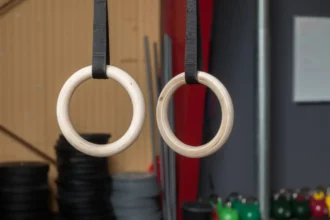Gymnastic rings, a cornerstone in both Olympic gymnastics and contemporary functional fitness regimes, offer a unique mix of simplicity and challenge. These understated yet versatile tools effectively target a broad spectrum of muscle groups. But can they also sculpt and strengthen the abs, a highly coveted area for fitness enthusiasts, in a way that no other tool can?
Anatomy of a Ring Workout: What Muscles Are Engaged?
Gymnastic rings are typically made of wood or composite materials and are suspended from a secure point, allowing them to move freely. This free movement adds a layer of instability to exercises, which requires the body to engage additional stabilizing muscles to maintain balance and control.
Here’s an overview of the major muscle groups typically engaged during a typical ring workout:
Upper Body and Arm Muscles
Gymnastic rings are highly effective for enhancing upper body strength. Exercises such as pull-ups, dips, and push-ups become more challenging when performed on rings, significantly engaging the pectoral muscles, deltoids, biceps, and triceps.
These muscles must not only lift but also stabilize the body throughout the exercise. The necessity to continually adjust and maintain balance on the swinging rings results in a more intense workout compared to using fixed equipment.
Core Muscles
The inherent design of ring exercises demands extensive core engagement. Whether executing a muscle-up, a front lever, or a basic ring dip, core muscles—including the rectus abdominis, obliques, and transverse abdominis—must consistently stabilize the body against dynamic forces.
The instability of the rings compels these muscles to continually adapt and strengthen, enhancing core resilience and endurance
Lower Body Engagement
Although it may seem less obvious, the lower body also reaps significant benefits from gymnastic ring workouts. Exercises like ring-supported lunges and squats intensify the engagement of leg muscles—especially the quadriceps, hamstrings, and glutes—as they work harder to maintain balance.
Furthermore, the core’s critical role in stabilizing the body during these exercises increases the involvement of the lower back and hip flexors, enhancing the overall workout effectiveness
Back Muscles
The versatility of gymnastic rings supports a wide range of pull movements, essential for developing a strong back. Exercises such as ring rows and pull-ups heavily engage the latissimus dorsi, rhomboids, and trapezius muscles.
These activities not only enhance muscular endurance and strength but are also crucial for improving posture and reducing the risk of back injuries.
Core Muscles Activated by Gymnastic Rings: A Detailed Look
The core comprises a complex network of muscles encircling the torso, extending from the pelvis to the shoulders. Gymnastic rings are particularly effective in engaging these muscles, combining static holds and dynamic movements to challenge their balance and control.
1. Rectus Abdominis
Commonly known as the “six-pack” muscles, the rectus abdominis stretches between the ribs and the pubic bone at the front of the pelvis. Essential for trunk flexion, this muscle is heavily engaged in ring exercises like front levers and tuck sits, which require maintaining precise body positions and stability.
2. Obliques (Internal and External)
Located at the sides of the abdomen, the obliques are vital for torso rotation and lateral flexion. Exercises such as windshield wipers and side planks on gymnastic rings challenge the obliques to stabilize the body against gravity, thereby enhancing their strength and endurance.
3. Transverse Abdominis
As the deepest layer of abdominal muscles, the transverse abdominis acts like a corset, wrapping around the spine to provide protection and stability. It’s activated during ring workouts that involve compressing the abdomen, like pulling the knees to the chest in a tuck or executing a strict muscle-up, improving core integrity and functionality.
Ring Exercises for Targeted Abdominal Training
When it comes to sculpting a strong, resilient core, variety in your exercise routine is key. Incorporating tools like gymnastic rings can elevate traditional exercises, pushing your abdominal muscles to new levels of strength and endurance. We’ll introduce two popular core exercises, providing a fresh perspective on targeted abdominal training.
Ring Adaptation of the Ab Wheel Rollout
Traditional Ab Wheel Rollout:
The conventional ab wheel rollout is renowned for its intense core engagement. This exercise involves kneeling and rolling a wheel forward until the body is extended and parallel to the floor, then pulling back to the starting position, primarily targeting the rectus abdominis and transverse abdominis.
Ring Rollout:
To adapt this exercise to gymnastic rings, set the rings just above the ground. From a similar kneeling position, grasp the rings and roll forward, extending your arms and lowering your body into a plank-like position before retracting to the starting posture.
The instability of the rings amplifies core muscle engagement, requiring more dynamic stabilization and providing a more challenging workout. This variation not only strengthens the abdominals but also enhances coordination and balance, elements crucial in comprehensive core training.
Bird Dog Exercise on Rings
Traditional Bird Dog:
The bird dog is a fundamental core exercise that also improves coordination and spinal stabilization. Performed on all fours, it involves extending one arm and the opposite leg simultaneously, maintaining the position to engage the core before switching sides.
Ring Bird Dog:
Adapting the bird dog to gymnastic rings adds a new layer of complexity. Set the rings at a low height, grasp them while maintaining a grounded knee position, and extend the opposite arm and leg, mirroring the traditional exercise.
The rings introduce instability that requires the core muscles, particularly the obliques and transverse abdominis, to work harder, thus enhancing balance and posture. This adaptation not only more effectively targets the core but also engages shoulder stabilizers and boosts proprioceptive abilities.
Combining Ring Exercises for Comprehensive Core Development
Integrating these ring-adapted exercises into a core workout routine ensures a holistic approach to abdominal training. The ring rollout tests the core’s ability to stabilize during dynamic movement, while the ring bird dog focuses on balance and coordination, promoting well-rounded development.
Together, these exercises provide a formidable workout that strengthens the core, builds functional strength, and enhances overall athletic performance.
Final thought
Do gymnastic rings strengthen the abs? Absolutely! To fully harness the benefits of gymnastic rings for your core, it’s crucial to maintain proper form and progressively increase the intensity of your workouts.
For anyone aiming to boost abdominal strength and achieve a comprehensive fitness routine, adding gymnastic ring exercises can be an invaluable part of their training regimen.





